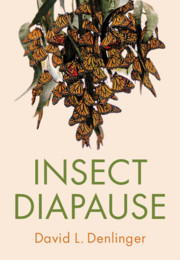Book contents
- Insect Diapause
- Insect Diapause
- Copyright page
- Dedication
- Contents
- Preface
- 1 Confronting the Challenges of a Seasonal Environment
- 2 Which Seasons Are Being Avoided?
- 3 Variation in the Diapause Response
- 4 The Cost of Diapause and Some Diapause Alternatives
- 5 Interpreting Seasonal Cues to Program Diapause Entry
- 6 Preparing for Diapause
- 7 The Diapause State
- 8 Ending Diapause and Reinitiating Development
- 9 Molecular Signaling Pathways that Regulate Diapause
- 10 Genetic Control of Diapause
- 11 Evolution of Diapause
- 12 Wider Implications
- References
- Species Index
- Subject Index
- Plate Section (PDF Only)
8 - Ending Diapause and Reinitiating Development
Published online by Cambridge University Press: 13 January 2022
- Insect Diapause
- Insect Diapause
- Copyright page
- Dedication
- Contents
- Preface
- 1 Confronting the Challenges of a Seasonal Environment
- 2 Which Seasons Are Being Avoided?
- 3 Variation in the Diapause Response
- 4 The Cost of Diapause and Some Diapause Alternatives
- 5 Interpreting Seasonal Cues to Program Diapause Entry
- 6 Preparing for Diapause
- 7 The Diapause State
- 8 Ending Diapause and Reinitiating Development
- 9 Molecular Signaling Pathways that Regulate Diapause
- 10 Genetic Control of Diapause
- 11 Evolution of Diapause
- 12 Wider Implications
- References
- Species Index
- Subject Index
- Plate Section (PDF Only)
Summary
Correctly timing the break of diapause and reactivation of development is critical for synchronizing the insect with its food source as well as optimizing mating opportunities. In many cases, diapause is actually broken (i.e., the insect is capable of developing) in early winter, but the progression of development is suppressed by the prevailing low temperatures. This post-diapause quiescence is followed by resumption of development when temperatures rise above a developmental threshold in the spring. This mechanism allows insects that have entered diapause at different times to be stockpiled in post-diapause quiescence and then develop synchronously in the spring. Alterations in the timing of spring development have led to host plant specialization and speciation. Several environmental factors, including chilling, daylength, rainfall patterns, and food availability, exert an influence on diapause duration, and an internal energy-sensing mechanism plays a key role in monitoring levels of energy reserves available to the insect.
Keywords
- Type
- Chapter
- Information
- Insect Diapause , pp. 216 - 239Publisher: Cambridge University PressPrint publication year: 2022
- 1
- Cited by

